day by day: a blog
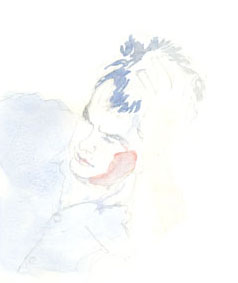 Why not say what happened?
Why not say what happened?
– Robert Lowell
There is no consciously sustained theme uniting these images or rationalizing their sequence, and there is no special telos underlying these notes. What happened was simply that each of these pictures meant something special to me on one particular day or that I noticed myself reflecting on a subject which the picture illustrates. And then the sun came up on another day in California, and I found myself thinking about something else. Each entry is just an image, a memory or a notion which, for a moment or so, opened itself to me, or me to it. To produce a few lines explaining what occurred and why is, for me, enough. I feel, I think, therefore I write...*
a story about modernity
The Situation: We see each other five days a week but we never talk. Like two diligent ants committed to our dull, programmed pre-conscious tasks we routinely park almost next to each other in the same featureless cul-de-sac when we drop our kids off at the elementary school. But, for all this, we work circumspectly but systematically to remain strangers. In the morning freshness, eye contact is scrupulously avoided and no bracing or cheery words, nor even manly nods, ever get exchanged. Truly, we practice the indifference of robots. He walks by me as if, were you to stop him and unscrew the covering on one of his plastic eyeballs, you would uncover a large photosensitive cell and a few wires. And if you were to unscrew me?
Footnotes to the Situation: He is short, dark-haired and dresses with a simplified stylishness. I know he is a scientist (company directory, working back from his daughter's name). From seeing that we drive back from school in the same general direction, I know too that he and his child live in the same part of town, as we do.
Observation: He gets under my skin.
Questions: Does my anger or fear (camouflaged sometimes as pity) derive from the red blotches on his cheeks, infallibly denoting the heavy drinker? Does it come from seeing that his car, though as bland in design as mine, is larger and more powerful (and thus more expensive) than mine? In other words, is this a socially derived frenzy (or jealousy?) on my part – the class anxiety of the irrelevant humanist before the trophies of science's sedulous acolyte? Does my anger (camouflaged sometimes as concern) come from suspecting that he is a disturbed man, a bully? I instance here his drives home, the blue car flashing past my stolid green vehicle, which have been more than once at dangerously high speed, manifesting the symptoms of road-rage – for example, the aggressive shrieking of his horn at dawdlers, the weaving between lanes, the determination to be first away from the light?
Or does this anger come from the mere fact of my being a so truly weak and resourceless character that when another person systematically (and perhaps pathologically?) ignores my existence, somewhere inside my ant mind I feel manically prompted to "take action"? Though of course, let me be very clear about this, the "action" I am talking about here exists only in fantasy, albeit that "action" is of a darkly retributive nature.
Conclusion: The thought occurs to me that if we had had the misfortune to be living say two thousand years ago, I would have designed a careful, essentially cowardly, ambush, knocked him in the eye (he would never hunt again), and (if he didn't get me first) would have walked off with his fur hat and arrows. And, in this daydream of mine, I flatter myself that the village would have thanked me.
[Author's note: No intended resemblances exist between the entirely fictional person described here and any living person. And if any are imagined, the similarities discerned are entirely fallacious in nature.]
annals of black sheep: henry straith venn
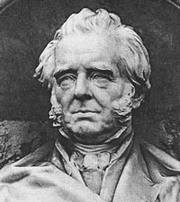 [image: Henry Venn, 1759-1813, Henry Straith Venn's great-grandfather] The ancestral line of Henry Straith Venn (1869-1908) was a weighty, chronicled one stocked almost entirely on the male side by distinguished, formidable, moralistic churchmen. Henry's great-uncle, John Venn, was the logician who introduced the 'Venn diagram', that pleasingly bulbous, promiscuous mathematical diagram. But the impression created by Henry Straith Venn's family history is one of purely, rigidly straight (or Straith) lines.
[image: Henry Venn, 1759-1813, Henry Straith Venn's great-grandfather] The ancestral line of Henry Straith Venn (1869-1908) was a weighty, chronicled one stocked almost entirely on the male side by distinguished, formidable, moralistic churchmen. Henry's great-uncle, John Venn, was the logician who introduced the 'Venn diagram', that pleasingly bulbous, promiscuous mathematical diagram. But the impression created by Henry Straith Venn's family history is one of purely, rigidly straight (or Straith) lines.
His great-great-grandfather, the famous Rev. Henry Venn (1725-1797), was descended 'from an unbroken succession of clergymen from the time of the Reformation' (ODNB). The Rev. Venn, one of the Clapham 'Saints', was a founding figure in the British abolitionist movement. He attacked Methodists for making 'the ground of their Assurance an inward fleeting instead of the faithfulness of Jehovah, the sensation of a fluctuating heart instead of the unchangeable promises of God'. The Venn family itself, in its unvarying names and starkly consistent beliefs, seemed to give an analogy on earth to the inflexible rightness and unchangingness of the God above Whom they worshipped so sedulously.
Henry Straith Venn's great-grandfather, the Rev. John Venn (1759-1813), was the first chair of the Church Missionary Society and the rector of Clapham, still in his time a centre of radical evangelicism and abolitionism: he was the 'spiritual guide' to many of the most eminent anti-slavery campaigners in the Clapham Sect. Henry Straith Venn's grandfather, the Rev. Henry Venn (1796-1873), was an Honorary Secretary of the Church Missionary Society in London for some 32 years. Henry Straith Venn's father was Rev. Henry Venn (1838-1923), an Honorary Canon of Canterbury. One of Henry Straith Venn's sisters was married to a vicar who became the Bishop of Lewes (another was married to a cartoonist with Punch).
There was only the occasional swerve in the linearity of Venn family traditions. Here was one. In 1888, at the age of 18, Henry Straith Venn went up to his father's old college, Gonville and Caius in Cambridge. He stayed a single term. Within a year, Henry Straith Venn, from motivations unknown, was to be found farming, far away from Clapham and Cambridge, in Alleghany County, Virginia. In 1906 he married Miss Maria Garnett, the daughter of a lawyer from Washington, DC. Less than a year and a half later, Henry Straight Venn, the great-great-grandson of the Rev. Henry Venn who had consorted with notables such as the Countess of Huntingdon and the Earl of Dartmouth, died in America at the age of 38.
SWithin six months, on July 1908, Maria Venn, his widow, gave birth to a boy, Henry Garnett Venn, a first and last child. As if Someone were intent on abolishing this whole errant Venn line, this touchingly human blemish on the family record, fatherless Henry Garnett Venn soon followed his progenitor into the bosom of God, dying three days after his birth, on 6 July 1908.
----------
'What's the point of this?' you ask me. 'Why bother?'
I answer: 'What else should a writer do except remember as honestly as possible? All the theories and cases and interpretations and axioms -- unless they are grounded in the actual, they are worthless. That's what I believe, even if it makes me a black sheep.'
ernst toller and ada doom
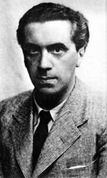 [image: Ernst Toller; source: IZRG-Bildarchiv] Auden's 1939 string of elegies and farewellings – 'In Memory of W. B. Yeats', 'In Memory of Ernst Toller', 'September 1, 1939', and 'In Memory of Sigmund Freud' – contain some curiously discordant notes, as if there were some anarchic or nihilistic principle in them struggling against the ostensible protocol of solemnity.
[image: Ernst Toller; source: IZRG-Bildarchiv] Auden's 1939 string of elegies and farewellings – 'In Memory of W. B. Yeats', 'In Memory of Ernst Toller', 'September 1, 1939', and 'In Memory of Sigmund Freud' – contain some curiously discordant notes, as if there were some anarchic or nihilistic principle in them struggling against the ostensible protocol of solemnity.
For example, the Yeats elegy is filled with some fanciful Tennysonian echoes, which seem to hint at an odd analogy between the Irish poet and the Duke of Wellington. And the gravely preoccupied and anguished 'September 1, 1939' (so much in the news in recently; I suppose, given that Auden said he finished the poem on 3 September 1939, one could say that the poem was completed 70 years ago today) begins with evocations of Ogden Nash's insouciant poem, 'Spring Comes to Murray Hill'.
I noticed another freakish note, this time in 'In Memory of Ernst Toller'. In that poem, written in May 1939, after Toller, whom Auden knew fairly well, had hanged himself in a New York hotel, Auden ponders the possible reasons for Toller's suicide. He wonders whether some early trauma was the ultimate cause: 'Did the small child see something horrid in the woodshed | Long ago?'
What is strange about this is that the question in this very depressed, subdued poem is couched in terms provided by a flagrantly comic novel of the period. Cold Comfort Farm, published by Stella Gibbons in 1932, is the story of the orphaned Flora Poste's stay with her relatives the Starkadders at Cold Comfort Farm in Howling, Sussex. The novel relates Flora's attempts to help the inhabitants of this strange outpost of madness in the heart of the English countryside become just slightly less eccentric.
One such inhabitant is the malevolent Aunt Ada Doom, 'the curse of Cold Comfort', who has been locked away upstairs for 20 years. Aunt Ada, Gibbons writes, became deranged as a result of an incident in childhood: 'When you were small – so small the lightest puff of breeze blew your little crinoline skirt over your head – you had seen something nasty in the woodshed.' The phrase 'something nasty in the woodshed' (with which Auden's 'something horrid in the woodshed' in the Toller elegy is virtually interchangeable) becomes something of a comic refrain in the later part of Cold Comfort Farm.
What? A phrase from a famous Stella Gibbons satire of the agricultural novel in a poem by Auden about a German émigré? Can it mean anything? It must. Borrowings are never innocent, sterilized or inert in lyric poetry. Language cannot be recycled without bringing some memory of its original use and context into the new poetic setting. Here, glancingly, Auden hints through his use of a phrase from Gibbons's satiric novel at a relationship between the inner world of Toller, the hyper-sophisticated, male, left-wing activist and playwright and that of a splenetic old woman who has sat for two decades in a room in Sussex obsessed by a terrible moment from her childhood.
My guess is that Auden himself would have offered a brilliantly odd psychoanalytic rationale for the comparison, justifying his move as a species of what Lukács called in a haunting phrase a 'looking beyond the palpable'.
There is probably much to be said for such an explanation. But, when this linguistic moment is set alongside other similarly outré, bizarre or counter-logical notes, such as those I briefly described earlier, which sound in Auden's poems of 1939, then it seems right to add that some other point – a point about poetry itself – is being made simultaneously with a point about the psyche. In the year when the Second World War began, Auden's poetry keeps returning in varying fashions to this 'monstrous' mode of yoking dissimilarities (Yeats and the Duke of Wellington, Toller and Aunt Ada) violently together without attempting to synthesize or harmonize the dissonances.
I see in these moments within Auden's poems something dialectical, even a bit libertarian in play. In 1939 poets may no longer pose as the tyrannical presences systematizing and co-coordinating into a single, unified 'Gleichschaltung' the society of their poems. In every verbal world some visible or audible token of non-participation or anti-commitment to the serious goal the work seems intent on enacting must be present. Just at the moment when, especially at the moment when, the poet appears engaged on the most serious of tasks, then where socially engaged Ego was, there shall poetic Id be.
nobility and poetry
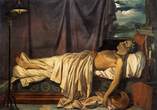 [Lord Byron on His Death-Bed, by Joseph-Denis Odevaere, about 1826] 'There is no element more conspicuously absent from contemporary poetry than nobility', Stevens wrote. Perhaps in a very literal way we should restore 'nobility' to the history of contemporary poetry, if for no other reason than because it seems foreign to the field? Stevens did not quite mean it in this way, but it is true to say that one sociological theme almost entirely ignored is the dynastic and aristocratic, the 'noble', dimension to a certain strand of English poetry.
[Lord Byron on His Death-Bed, by Joseph-Denis Odevaere, about 1826] 'There is no element more conspicuously absent from contemporary poetry than nobility', Stevens wrote. Perhaps in a very literal way we should restore 'nobility' to the history of contemporary poetry, if for no other reason than because it seems foreign to the field? Stevens did not quite mean it in this way, but it is true to say that one sociological theme almost entirely ignored is the dynastic and aristocratic, the 'noble', dimension to a certain strand of English poetry.
Think about this odd fact as you consider the general proposition. Between Lord Byron and Robert Lowell, a certain strand of self-consciously authoritative, seigneurial English male poets all had Plantangenet ancestors. Thus,
Byron was a 16 times great-grandson of Henry III of England (1207-1272)
Shelley was an 18 times great-grandson of Henry III
Tennyson was a 17 times great-grandson of Henry III
Swinburne was a 20 times great-grandson of Henry III
Eliot was an 18 times great-grandson of Henry III
Auden was a 20 times great-grandson of Henry III
Robert Lowell was a 21 times great-grandson of Henry III
These poets were all therefore distantly but discernibly related to one another. For example, Auden was
the 16th cousin, four times removed of Byron
the 16th cousin, three times removed of Shelley
the 14th cousin, twice removed of Tennyson
the 11th cousin, once removed of Swinburne
the 17th cousin, three times removed of Eliot
and the 18th cousin, once removed of Robert Lowell
Poetry has always been a tiny world. We always knew that, not without some anxiety. Perhaps it has also, in a certain way, always been a familial world? A world of hermetic 'connections'? Verbally and socially an aristocratic world? A world which has favoured the kind of imagination and speech patterns cultivated by people from a privileged class?
Personally, I find it unpleasant -- dismaying, unsettling, even -- to entertain the possibility that such notions as these are valid. Who wants to be in love with a corrupt medium? Who wants to entertain the idea that the sublimated version of an aristocratic voice is what one secretly, basely, in spite of oneself, worships in poetry, that this is what characterizes a kind of poem one reverences? There may be something here for people like me to face up to. Hypocrite lecteur, must I learn to believe that noblesse really does oblige?
family business
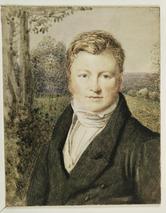 [image: John Varley (1778-1842), by John Linnell] Sometimes, as cell by solitary, database cell I monotonously and relentlessly build up the genealogical reef that is the Family Ghosts website, I get the feeling, slightly Pynchonesque in a paranoid way, that every intellectual affiliation is subtended by an occult family connection.
[image: John Varley (1778-1842), by John Linnell] Sometimes, as cell by solitary, database cell I monotonously and relentlessly build up the genealogical reef that is the Family Ghosts website, I get the feeling, slightly Pynchonesque in a paranoid way, that every intellectual affiliation is subtended by an occult family connection.
Take W. B. Yeats’s well-known fascination at the end of the 19th century with the works of Blake and Shelley. Critics have usually parsed this passionate interest in the visionary strain of Romanticism either as being Yeats's way of disaffiliating himself from his father's mid-Victorian rationalism or as being symptomatic of the common Anglo-Irish obsession with the supernatural. Or, of course, as being both.
Yet it has apparently escaped notice that to the young Yeats Blake and Shelley must have been almost living, breathing presences, alive to him through a family tie. Yeats's mystically-inclined aunt, Isabella Pollexfen (1849-1938), who lived in London and gave her nephew a copy of A. P. Sinnett's Esoteric Buddhism in 1884, was married to the landscape artist John Varley (1850-1933).
Varley was the grandson of another well-known artist, also called John Varley (1778-1842). Both grandfather and grandson was fascinated by astrology and the occult, and the elder Varley was a close friend of William Blake. Varley and Blake shared a metaphysical fascination. Varley encouraged and took seriously Blake's visions. Indeed, between 1819 and 1825 during evenings at Varley's house in Great Titchfield Street, London, Varley and Blake collaborated on the 'Visionary Heads' project, producing together some 187 portraits of 'historical and imaginary figures' they saw in visions there. (For a detailed diagram of Yeats's relation to John Varley, click here.)
Yeats's uncle, the younger John Varley (1850-1933), was also the great-nephew of John Gisborne (d. 1835/36), who in 1800 married Maria Reveley (1770-1836), the friend of Godwin, Wollstonecraft and the Shelleys and to whom in July 1820 P. B. Shelley wrote the 'Letter to Maria Gisborne' while staying in the Gisbornes' house in Leghorn. In other words, Yeats's uncle was the great-nephew of Maria Gisborne. (For a detailed diagram of Yeats's relation to Maria Gisborne, click here.)
These faint, almost diaphanous but still suggestive, human connections stretching between Yeats and his iconic predecessors are not determinative. At least, I am certainly not willing to say they are. However, knowledge of them does add within the arid, abstract outlines of intellectual history a sense of subtle, emotional tincturing and warm plasticity, like a Romantically-shining watercolour wash added to a neoclassically-schematized, inked face.
When, in this familial context, Yeats studied the writings of Blake and Shelley perhaps it was almost -- subliminally or not, and in a way immediately reminiscent of the visitations from the beyond occurring at the séances which Yeats habitually attended during the period when he was also studying these artists – perhaps it was almost as if he heard their living voices murmuring to him from an adjoining room.
Through the younger John Varley, his uncle, the youthful W. B. Yeats might have seemed tantalizingly close to being 'in touch' with his chosen predecessors. Browning, in 'Memorabilia', supplied the essential poetic gloss on this eerie amalgam of nearness and farness which can sometimes be incarnated in an otherwise somewhat ordinary person:
Ah, did you once see Shelley plain,
And did he stop and speak to you?
And did you speak to him again?
How strange it seems, and new!
No-one, least of all me, can be immune to the frisson of that asymptotic approach to so much creativity and vitality, to that romance of feeling, for a while, only 'at one remove' from what we imagine to be the fully emancipated life.
With the exception of the interspersed quotations, all writing © 2007-2010 by Nicholas Jenkins [back]